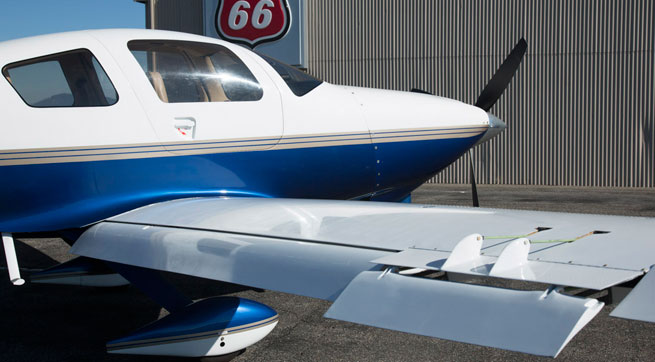Airframe: Rethinking roll control
Lam aileron system makes crisper, more rapid rolls

Ailerons have been well studied and thoroughly understood in the century since aviation pioneer Glenn Curtiss invented them for roll control. But can they be improved?
Michael Lam thinks his late father, Larry Lam—an aeronautical engineer and inventor—came up with a better way. And Michael has patented and is actively marketing a new system that he says can accomplish the seemingly contradictory goals of raising cruise speed, climb rate, and roll authority while at the same time lowering stall speed and reducing adverse yaw.
Lam’s testbed is a Columbia 300 to which his team has attached a redesigned wing that has less area, greater span, a more efficient airfoil, and additional control surfaces that allow the airplane to fly both faster and slower than with its stock wing. The new technology is being evaluated by several aircraft manufacturers, and Lam hopes to license the system—and perhaps build entirely new composite wings—for a variety of customers.
I recently flew the modified aircraft with test pilot Len Fox and can attest that it performs exceptionally well at low airspeeds where the Lam system makes rolls noticeably crisper and more rapid.
“A key difference with this system is that it provides both more aileron and more flap,” Fox said. “A traditional wing allows an increase in one or the other, but not both. What a designer added in one area had to be subtracted from the other.”
The test aircraft wings are equipped with traditional, mechanical ailerons on the outboard portions: electronically actuated Lam flaps and Lam ailerons in the middle; and traditional flaps on the inboard sections. The traditional ailerons deflect up and down normally as the pilot moves the control stick from side to side. When the mechanical ailerons deflect more than a few degrees, electronic servos inside the wings activate the Lam ailerons and move them in tandem with the traditional ailerons, effectively increasing aileron area and boosting roll rate.
“The Lam ailerons are dormant for the first few degrees of travel for the traditional ailerons,” Fox said. “They activate with greater aileron deflection. It’s all seamless to the pilot, and the feeling is smooth and natural. It’s not at all twitchy or artificial.”
The pilot can raise and lower the Fowler-style Lam flaps independent of the traditional flaps. Both sets of flaps are controlled electronically via rocker switches on the airplane’s center console.
Unlike the cuffed wings on the FAA-certified Columbia, Cessna Corvallis, and Cirrus models, the test aircraft wing leading edges are clean. (The composite wings were designed and built by Greg Cole of Windward Performance in Bend, Oregon.)
“The smaller wing area; higher aspect ratio; and the lack of cuffs, stall strips, or other leading-edge devices make the new wing more efficient, particularly at higher altitudes,” said Fox, who performed FAA-mandated spin resistance tests on the Columbia 350 and actual spin tests on the 400 model. “Cruise speeds are between 12 and 16 knots faster than the original wing, max climb rates are several hundred feet per minute higher, the stall speed is about one knot slower, and roll rates are faster.”
Aircraft designers have long sought to improve performance by altering wing shapes, materials, and control surfaces—and the results are mixed. Mitsubishi incorporated a relatively small, highly loaded wing; full-span flaps; and spoilers on its MU–2. Others have used flaperons, drooped ailerons, and vortex generators to improve low-speed handling. Lam ailerons differ from spoilers in that the Lam system doesn’t try to reduce or eliminate lift.
During an hour-long flight with AOPA Senior Photographer Mike Fizer and me aboard, Fox demonstrated the test airplane’s impressive climb, cruise, and slow-flight performance. The aircraft stalled at 61 KIAS with traditional flaps deployed and 59 KIAS with both traditional and Lam flaps down. During slow flight at 75 KIAS, roll response was authoritative and quick. Roll rates at full aileron deflection were markedly faster with the Lam system engaged than when it was intentionally disabled.
In case of electrical failure, airflow over the wings pushes the Lam ailerons down to a trail position and roll control reverts to traditional ailerons only. Future possibilities include an all-electric Lam system with full-span flaps.
Fox said he’s impressed by the documented performance gains the test aircraft is delivering with its new wing and aileron system—and he’s intrigued by the potential this technology seems to offer in other, as yet untested areas such as spin resistance and recovery. He said an RC model with Lam ailerons has demonstrated vastly enhanced spin resistance and unusually quick spin recovery. “As a test pilot, I’m intrigued,” Fox said. “I’d like to see the promise of this system fully explored.”
Email [email protected]
Web: www.lamaviation.com



